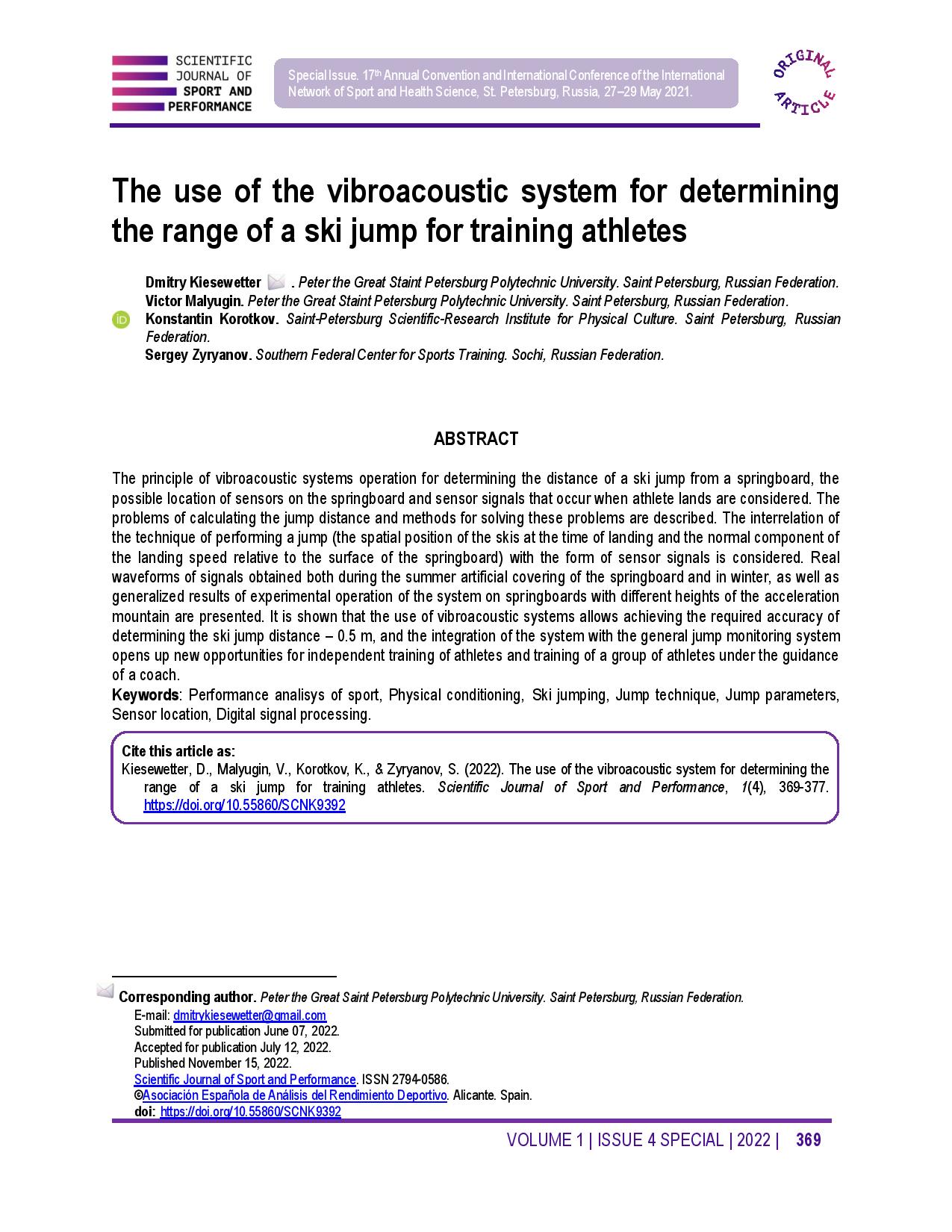The use of the vibroacoustic system for determining the range of a ski jump for training athletes
Main Article Content
Abstract
The principle of vibroacoustic systems operation for determining the distance of a ski jump from a springboard, the possible location of sensors on the springboard and sensor signals that occur when athlete lands are considered. The problems of calculating the jump distance and methods for solving these problems are described. The interrelation of the technique of performing a jump (the spatial position of the skis at the time of landing and the normal component of the landing speed relative to the surface of the springboard) with the form of sensor signals is considered. Real waveforms of signals obtained both during the summer artificial covering of the springboard and in winter, as well as generalized results of experimental operation of the system on springboards with different heights of the acceleration mountain are presented. It is shown that the use of vibroacoustic systems allows achieving the required accuracy of determining the ski jump distance – 0.5 m, and the integration of the system with the general jump monitoring system opens up new opportunities for independent training of athletes and training of a group of athletes under the guidance of a coach.
Article Details

This work is licensed under a Creative Commons Attribution-NonCommercial-ShareAlike 4.0 International License.
References
Bychkov, G.G., Aronov, V.I. (1993): USSR copyright certificate No 1836971, cl. A 63B 5/11. The device for determining the length of the ski jumping (in Russian).
International ski federation. (2018, June). The international ski competition rules (ICR). Book III. Ski jumping. Retrieved from: https://assets.fis-ski.com/image/upload/v1536927329/fis-prod/assets/International_Competition_Rules_ICR_Ski_Jumping.pdf
Kiesewetter D., Korotkov K., Malyugin V. (2015). Lecture Notes in Computer Science: Vol. 9247. The Automated System for Collection, Processing and Transmission of Data for Training and Competitive Process in Ski Jumping. Internet of Things, Smart Spaces, and Next Generation Networks and Systems. Springer, Cham. https://doi.org/10.1007/978-3-319-23126-6_41 DOI: https://doi.org/10.1007/978-3-319-23126-6_41
Kiesewetter, D., Malyugin, V., Makarov, S., Korotkov, K., Diao Ming and Xue Wei. (2016). Application of the optical fibers in the system of determining the distance of jump at ski springboard. 2016 Advances in Wireless and Optical Communications (RTUWO), 5 – 8, https://doi.org/10.1109/rtuwo.2016.7821845 DOI: https://doi.org/10.1109/RTUWO.2016.7821845
Slavskii, V.F., Kuramshin, A.M., Kalinin, Y.V., Korotkov, K.G., Sinister, A.A., Zakharov, G.G., Shelkov, O.M., Malyugin, V.I., Kiesewetter, D.V. (2011, March 10): The device for measuring the length of the ski jumping. Patent RF No 102789 U8, G01B7/00 (in Russian).
US Patent No 4089057-A (1978, May 9): Method and Device for Measuring Jump-lengths on a Ski-jump. Cl. G01B7/00.




